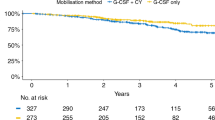Abstract
A number of different regimens have evolved for the mobilisation of peripheral blood stem cells for autologous transplantation in patients with lymphoma or myeloma. A successful regimen could be defined as one which consistently resulted in the collection of an optimal number of CD34+ cells with a minimum number of apheresis procedures with minimal toxicity. Initial protocols, which used chemotherapy alone as a mobilising agent, have now been replaced by regimens involving the use of haematopoietic growth factors either alone or in combination with variable doses of cyclophosphamide. Although there is good evidence that high-dose cyclophosphamide (6–7 g/m2) is an effective mobilising agent it is associated with significant toxicity and many groups have now utilised lower doses of cyclophosphamide with reduced toxicity which have still proven to be effective in the majority of patients. More recently a number of ‘second generation’ combined salvage chemotherapy and mobilisation regimens have been reported for use in the lymphomas which have the advantage of avoiding a specific stem cell mobilisation step and at the same time appear more consistently effective at mobilising stem cells than cyclophosphamide and G-CSF. These regimens are associated with fewer ‘poor-mobilisers’ and indeed some patients who have failed previous mobilisation with cyclophosphamide and G-CSF have been successfully re-mobilised. It is clear that in both lymphoma and myeloma patients the success of PBSC mobilisation is affected by the amount and type of previous chemotherapy and radiotherapy and probably other pre-treatment factors as exemplified by variability seen in normal donors mobilised with G-CSF alone. In myeloma most groups have utilised cyclophosphamide in variable doses in combination with G-CSF or GM-CSF. However, recent randomised studies have confirmed that G-CSF alone is an effective and non-toxic alternative although it appears that the efficacy of G-CSF as a single agent is related to the dosage used with daily doses of 16 μg/kg/day or greater being most effective. Thus, disease-specific mobilisation strategies appear to be emerging and these will undoubtedly be modified further as more is understood concerning the biology of blood stem cell mobilisation.
This is a preview of subscription content, access via your institution
Access options
Subscribe to this journal
Receive 12 print issues and online access
$259.00 per year
only $21.58 per issue
Buy this article
- Purchase on Springer Link
- Instant access to full article PDF
Prices may be subject to local taxes which are calculated during checkout
Similar content being viewed by others
Author information
Authors and Affiliations
Rights and permissions
About this article
Cite this article
Russell, N., McQuaker, G., Stainer, C. et al. Stem cell mobilisation in lymphoproliferative diseases. Bone Marrow Transplant 22, 935–940 (1998). https://doi.org/10.1038/sj.bmt.1701477
Received:
Accepted:
Published:
Issue Date:
DOI: https://doi.org/10.1038/sj.bmt.1701477
Keywords
This article is cited by
-
Factors impacting stem cell mobilization failure rate and efficiency in multiple myeloma in the era of novel therapies: experience at Memorial Sloan Kettering Cancer Center
Bone Marrow Transplantation (2013)
-
Stem cell mobilization in patients with newly diagnosed multiple myeloma after lenalidomide induction therapy
Leukemia (2011)
-
Improving stem cell mobilization strategies: future directions
Bone Marrow Transplantation (2009)
-
Cyclophosphamide and cancer: golden anniversary
Nature Reviews Clinical Oncology (2009)
-
Current approaches in dendritic cell generation and future implications for cancer immunotherapy
Cancer Immunology, Immunotherapy (2007)



